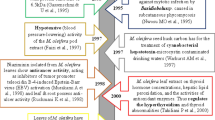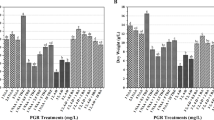Abstract
Gamma radiation (GR) and salicylic acid (SA) enhance plant traits by regulating growth and development. However, the underlying mechanism of their combined therapies in plants is not well understood. In our study, the potential impact of 100 μM and 500 μM SA and/or 20, 40 Gy in Momordica charantia, a medicinal crop plant was assessed. We observed significant increase in plant root-shoot length and photosynthetic efficiency at 20 Gy dose, which further enhanced under SA application. Overall, simultaneous application of SA and GR also upregulated antioxidant capacity via production of secondary metabolites, such as flavonoids and phenolics. The highest antidiabetic activity with up to 81.5% inhibition of alpha-amylase enzyme was observed at 20 Gy + 500 μM SA combination. The expression of Sterol C-22 Desaturase, a key gene involved in the biosynthesis of β-sitosterol was upregulated under the treatment of GR and/or SA. β-sitosterol is an important compound with potent anti-cholesterol and anti-carcinogenic properties. Our study showed that highest content of β-sitosterol (1082.2 ± 68.2 ng/mg FW) was observed in M. charantia plants exposed to combined 20 Gy + 500 μM SA treatment. Therefore, gamma irradiation and salicylic acid can help in sustainable growth and production of various secondary metabolites in M. charantia, thereby enhancing its agronomic value.
Key Message
Gamma radiation and salicylic acid improves plant growth, photosynthetic efficiency, and secondary metabolite accumulation in Momordica charantia. Moreover, it upregulates the phytosterol biosynthesis pathway and β-sitosterol content.





Similar content being viewed by others
Data availability
The datasets generated and/or analysed during the current study are available from the corresponding author upon request.
References
Ahamad J, Amin S, Mir SR (2015) Simultaneous quantification of gymnemic acid as gymnemagenin and charantin as β-sitosterol using validated HPTLC densitometric method. J Chromatogr Sci 53(7):1203–1209. https://doi.org/10.1093/chromsci/bmu166
Bagautdinova ZZ, Omelyanchuk N, Tyapkin AV, Kovrizhnykh VV, Lavrekha VV, Zemlyanskaya EV (2022) Salicylic acid in root growth and development. Int J Mol Sci 23(4):2228. https://doi.org/10.3390/ijms23042228
Borzouei A, Kafi M, Khazaei H, Naseriyan B, Majdabadi A (2010) Effects of gamma radiation on germination and physiological aspects of wheat (Triticum aestivum L.) seedlings. Pak J Bot 42(4):2281–2290
Brand-Williams W, Cuvelier ME, Berset C (1995) Use of a free radical method to evaluate antioxidant activity. Lebensm- WissTechnol 28:25–30. https://doi.org/10.1016/S0023-6438(95)80008-5
Cahill DM, McComb JA (1992) A comparison of changes in phenylalanine ammonia-lyase activity, lignin and phenolic synthesis in the roots of Eucalyptus calophylla (field resistant) and E. marginata (susceptible) when infected with Phytophthora cinnamomi. Physiol Mol Plant Pathol 40:315–332. https://doi.org/10.1016/0885-5765(92)90014-M
Çiçek SS (2022) Momordica charantia L.—Diabetes-related bioactivities, quality control, and safety considerations. Front Pharmacol 13:904643. https://doi.org/10.3389/fphar.2022.904643
De Capite A, Lancaster T, Puthoff D (2016) Salicylic acid treatment increases the levels of triterpene glycosides in black cohosh (Actaea Racemosa) rhizomes. J Chem Ecol 42:13–16. https://doi.org/10.1007/s10886-015-0655-x
Dutta S, Hazra P, Saha S, Acharya B, Bhattacharjee T, Maurya PK, Chattopadhyay A (2021) Applied mutagenesis could improve economically important traits in bitter gourd (Momordica charantia L.). J Genet 100(2):43. https://doi.org/10.1007/s12041-021-01283-5
El-Beltagi HS, Ahmed OK, El-Desouky W (2011) Effect of low doses c-irradiation on oxidative stress and secondary metabolites production of rosemary (Rosmarinus officinalis L.) callus culture. Radiat Phys Chem 80:968–976. https://doi.org/10.1016/j.radphyschem.2011.05.002
Fraga CG, Croft KD, Kennedy DO, Tomás-Barberán FA (2019) The effects of polyphenols and other bioactives on human health. Food Funct 10(2):514–528
Garcia-Mier L, Jimenez-Garcia SN, Guevara-González RG, Feregrino-Perez AA, Contreras-Medina LM, Torres-Pacheco I (2015) Elicitor mixtures significantly increase bioactive compounds, antioxidant activity, and quality parameters in sweet bell pepper. J Chem 2015:1–8. https://doi.org/10.1155/2015/269296
Griebel T, Zeier J (2010) A role for β-sitosterol to stigmasterol conversion in plant–pathogen interactions. Plant J 63(2):254–268. https://doi.org/10.1111/j.1365-313X.2010.04235.x
Grover JK, Yadav SP (2004) Pharmacological actions and potential uses of Momordica charantia: a review. J Ethnopharmacol 93(1):123–132. https://doi.org/10.1016/j.jep.2004.03.035
Hussain PR, Wani AM, Meena RS, Dar MA (2010) Gamma irradiation induced enhancement of phenylalanine ammonia-lyase (PAL) and antioxidant activity in peach (Prunus persica Bausch, Cv. Elberta). Radiat Phys Chem 79:982–989. https://doi.org/10.1016/j.radphyschem.2010.03.018
Jiang Y, Joyce DC (2003) ABA effects on ethylene production, PAL activity, anthocyanin and phenolic contents of strawberry fruit. Plant Growth Regul 39:171–174. https://doi.org/10.1023/A:1022539901044
Joseph B, Jini D (2013) Antidiabetic effects of Momordica charantia (bitter melon) and its medicinal potency. Asian Pacific J Trop Dis 3(2):93–102. https://doi.org/10.1016/S2222-1808(13)60052-3
Khalifa AM, Abd-ElShafy E, Abu-Khudir R, Gaafar RM (2022) Influence of gamma radiation and phenylalanine on secondary metabolites in callus cultures of milk thistle (Silybum marianum L.). J Genet Eng Biotechnol 20(1):1–11. https://doi.org/10.1186/s43141-022-00424-2
Khalvandi M, Siosemardeh A, Roohi E, Keramati S (2021) Salicylic acid alleviated the effect of drought stress on photosynthetic characteristics and leaf protein pattern in winter wheat. Heliyon 7(1). https://doi.org/10.1016/j.heliyon.2021.e05908
Khatun A, Hossain A, Islam M, Hossain A, Munshi K, Huque R (2012) Effect of gamma radiation on antioxidant marker and microbial safety of fresh bitter gourd (Momordica charantia L.). Int J Biosci 2(11):43–49
Kiani R, Arzani A, Mirmohammady Maibody SAM (2021) Polyphenols, flavonoids, and antioxidant activity involved in salt tolerance in wheat, Aegilops cylindrica and their amphidiploids. Front Plant Sci 12:646221
Kim JH, Baek MH, Chung BY, Wi SG, Kim JS (2004) Alterations in the photosynthetic pigments and antioxidant machineries of red pepper (Capsicum annuum L.) seedlings from gamma-irradiated seeds. J Plant Biol 47:314–321. https://doi.org/10.1007/BF03030546
Koo YM, Heo AY, Choi HW (2020) Salicylic acid as a safe plant protector and growth regulator. Plant Pathol J 36(1):1. https://doi.org/10.5423/PPJ.RW.12.2019.0295
Li A, Sun X, Liu L (2022) Action of salicylic acid on plant growth. Front Plant Sci 13:878076. https://doi.org/10.3389/fpls.2022.878076
Lichtenthaler HK (1987) Chlorophylls and carotenoids: pigments of photosynthetic biomembranes. Methods Enzymol 148:350–382. https://doi.org/10.1016/0076-6879(87)48036-1
Lin JY, Tang CY (2007) Determination of total phenolic and flavonoid contents in selected fruits and vegetables, as well as their stimulatory effects on mouse splenocyte proliferation. Food Chem 101(1):140–147. https://doi.org/10.1016/j.foodchem.2006.01.014
Loc NH, Giang NT, Huy ND (2016) Effect of salicylic acid on expression level of genes related with isoprenoid pathway in centella (Centella asiatica (L.) Urban) cells. 3 Biotech 6:1–7. https://doi.org/10.1007/s13205-016-0404-z
Maurya B, Rai KK, Pandey N, Sharma L, Goswami NK, Rai SP (2019) Influence of salicylic acid elicitation on secondary metabolites and biomass production in in-vitro cultured Withania coagulans (L.) Dunal. Plant Arch 19:1308–1316
Miura K, Lee J, Miura T, Hasegawa PM (2010) SIZ1 controls cell growth and plant development in Arabidopsis through salicylic acid. Plant Cell Physiol 51:103–113. https://doi.org/10.1093/pcp/pcp171
Muhallilin I, Aisyah SI, Sukma D (2019) The diversity of morphological characteristics and chemical content of Celosia cristata plantlets due to gamma ray irradiation. Biodiversitas J Biol Divers 20(3):862–866. https://doi.org/10.13057/biodiv/d200333
Paul A, Raychaudhuri SS (2010) Medicinal uses and molecular identification of two Momordica charantia varieties-a review. Electr J Biol 6(2):43–51
Pitipanapong J, Chitprasert S, Goto M, Jiratchariyakul W, Sasaki M, Shotipruk A (2007) New approach for extraction of charantin from Momordica charantia with pressurized liquid extraction. Sep Purif Technol 52(3):416–422. https://doi.org/10.1016/j.seppur.2005.11.037
Riviello-Flores MDLL, Cadena-Iñiguez J, Ruiz-Posadas LDM, Arévalo-Galarza MDL, Castillo-Juárez I, Soto Hernández M, Castillo-Martínez CR (2022) Use of gamma radiation for the genetic improvement of underutilized plant varieties. Plants 11(9):1161. https://doi.org/10.3390/plants11091161
Saeed F, Sultan MT, Riaz A, Ahmed S, Bigiu N, Amarowicz R, Manea R (2021) Bitter melon (Momordica charantia L.) fruit bioactives charantin and vicine potential for diabetes prophylaxis and treatment. Plants 10(4):730. https://doi.org/10.3390/plants10040730
Sesták Z, Catský J, Jarvis P (1971) Plant photosynthetic production: manual of methods. Dr. W, Junk
Sharma A, Rana S, Rather GA, Misra P, Dhar MK, Lattoo SK (2020) Characterization and overexpression of sterol Δ22-desaturase, a key enzyme modulates the biosyntheses of stigmasterol and withanolides in Withania somnifera (L.) Dunal. Plant Sci 301:110642
Sharma A, Kohli SK, Khanna K, Ramakrishnan M, Kumar V, Bhardwaj R, ... Zheng B (2023) Salicylic acid: a phenolic molecule with multiple roles in salt-stressed plants. J Plant Growth Regul 42(8):4581–4605
Shirazi Z, Aalami A, Tohidfar M, Sohani MM (2019) Triterpenoid gene expression and phytochemical content in Iranian licorice under salinity stress. Protoplasma 256:827–837. https://doi.org/10.1007/s00709-018-01340-4
Singleton VL (1999) Lamuela-Raventos: Analysis of total phenoles and other oxidation substartes and antioxidants by means of folin-ciocalteu reagent. Methods Enzymol 299:152. https://doi.org/10.1016/S0076-6879(99)99017-1
Sun H, Saeedi P, Karuranga S, Pinkepank M, Ogurtsova K, Duncan BB, ... Magliano DJ (2022) IDF Diabetes Atlas: Global, regional and country-level diabetes prevalence estimates for 2021 and projections for 2045. Diabetes Res Clin Pract 183:109119. https://doi.org/10.1016/j.diabres.2021.109119
Tajik S, Zarinkamar F, Soltani BM, Nazari M (2019) Induction of phenolic and flavonoid compounds in leaves of saffron (Crocus sativus L.) by salicylic acid. Scientia Horticulturae 257:108751. https://doi.org/10.1016/j.scienta.2019.108751
Teles ASC, Chávez DWH, Coelho MAZ, Rosenthal A, Gottschalk LMF, Tonon RV (2021) Combination of enzyme-assisted extraction and high hydrostatic pressure for phenolic compounds recovery from grape pomace. J Food Eng 288:110128. https://doi.org/10.1016/j.jfoodeng.2020.110128
Vanacker H, Lu H, Rate DN, Greenberg JT (2001) A role for salicylic acid and NPR1 in regulating cell growth in Arabidopsis. Plant J 28:209–216. https://doi.org/10.1046/j.1365-313X.2001.01158.x
Vardhan PV, Shukla LI (2017) Gamma irradiation of medicinally important plants and the enhancement of secondary metabolite production. Int J Radiat Biol 93(9):967–979
Walters DR, Havis ND, Paterson L, Taylor J, Walsh DJ, Sablou C (2014) Control of foliar pathogens of spring barley using a combination of resistance elicitors. Front Plant Sci 5:241
Wang L, Wu J, Lan F, Gao P (2020) Morphological, cytological and molecular variations induced by gamma rays in ‘Donglinruixue.’ Folia Horticulturae 32(1):87–96. https://doi.org/10.2478/fhort-2020-0009
Wi SG, Chung BY, Kim JS, Kim JH, Baek MH, Lee JW, Kim YS (2007) Effects of gamma irradiation on morphological changes and biological responses in plants. Micron 38(6):553–564. https://doi.org/10.1016/j.micron.2006.11.002
Acknowledgements
The authors would like to thank Dr. Aparna Dutta, Scientific Assistant-F, Radiation Chemistry Radiation Safety Officer, UGC DAE CSR Kolkata centre, for her assistance during gamma irradiation treatments. The authors would also like to thank senior technician of Spinco Biotech, Mr. Jayanta Mahato, for his valuable contribution in LC-MS/MS method development.
Funding
The authors would like to thank the funding agency, UGC- DAE Consortium for Scientific Research, Kolkata Centre, West Bengal (grant number-UGC-DAE-CSR-KC/CRS/19/RB-03/1046/1062), India for extending their financial support towards this work.
Author information
Authors and Affiliations
Contributions
Conceptualization: Sarmistha Sen Raychaudhuri and Anindita Chakraborty; Data curation: Saptaparna Dutta; Investigation: Saptaparna Dutta; Methodology: Saptaparna Dutta; Supervision: Sarmistha Sen Raychaudhuri; Validation: Writing – original draft: Saptaparna Dutta; Writing – review & editing: Saptaparna Dutta, Sankalan Dey, Sarmistha Sen Raychaudhuri and Anindita Chakraborty.
Corresponding author
Ethics declarations
Competing interests
The authors have no relevant financial or non-financial interests to disclose.
Additional information
Communicated by Konstantin V. Kiselev
Publisher's Note
Springer Nature remains neutral with regard to jurisdictional claims in published maps and institutional affiliations.
Supplementary Information
Below is the link to the electronic supplementary material.
Rights and permissions
Springer Nature or its licensor (e.g. a society or other partner) holds exclusive rights to this article under a publishing agreement with the author(s) or other rightsholder(s); author self-archiving of the accepted manuscript version of this article is solely governed by the terms of such publishing agreement and applicable law.
About this article
Cite this article
Dutta, S., Dey, S., Chakraborty, A. et al. Exogenous application of salicylic acid and low-dose ionizing radiation increases synthesis of bioactive compounds and upregulates phytosterol production of Bitter melon (Momordica charantia). Plant Cell Tiss Organ Cult 157, 63 (2024). https://doi.org/10.1007/s11240-024-02792-8
Received:
Accepted:
Published:
DOI: https://doi.org/10.1007/s11240-024-02792-8




